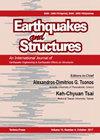用于结构抗震隔离的悬架柱:实验和数值研究
IF 1.1
4区 工程技术
Q3 ENGINEERING, CIVIL
引用次数: 1
摘要
本文研究了一种改进和改进的悬架隔震体系。对所提出的隔离方法进行了实验研究,并进行了理论和数值分析。在本文提出的方法中,在基础施工时,在基础内柱的位置设置一些空腔,将柱放置在空腔内,并通过柔性电缆悬挂在基础上,而不是直接与基础相连。由于柱是悬浮的,并且由于柱和腔墙之间的间隙,结构能够自由地向每一侧移动,因此减少了传递的地震作用。这种隔离技术的主要参数是悬索的长度。随着电缆长度的变化,结构的固有频率也会发生变化,因此,通过适当的电缆长度可以达到所需的频率。作为研究的实验阶段,建造了一个两层的钢框架结构,并使用不同悬索长度的振动台承受三次地震的加速度。结构响应记录在加速度和相对位移方面。将实验结果与MATLAB编程和有限元软件ABAQUS的理论和数值结果进行了比较,结果表明两者吻合较好。结果证实了所提出的隔震方法在减小地震对结构的影响方面的有效性。本文章由计算机程序翻译,如有差异,请以英文原文为准。
Suspended Columns for Seismic Isolation in Structures (SCSI):Experimental and numerical studies
In this paper, a modified and improved seismic isolation system called suspension columns for seismic isolation was investigated. An experimental study of the proposed isolation method, together with theoretical and numerical analyses, has thoroughly been conducted. In the proposed method, during the construction of the foundation, some cavities are created at the position of the columns inside the foundation and the columns are placed inside the cavities and hanged from the foundation by flexible cables rather being directly connected to the foundation. Since the columns are suspended and due to the gap between the columns and walls of the cavities, the structure is able to move freely to each side thus, the transmitted seismic actions are reduced. The main parameter of this isolation technique is the length of the suspension cable. As the cable length is changed, the natural frequency of the structure is also changed, thus, the desired frequency can be achieved by means of an appropriate cable length. As the experimental phase of the study, a steel frame structure with two floors was constructed and subjected to the acceleration of three earthquakes using a shaking table with different hanging cable lengths. The structural responses were recorded in terms of acceleration and relative displacement. The experimental results were compared to the theoretical and numerical ones, obtained from the MATLAB programming and the finite element software ABAQUS, showing a suitable agreement between them. The results confirm the effectiveness of the proposed isolation method in reducing the seismic effects on the structure.
求助全文
通过发布文献求助,成功后即可免费获取论文全文。
去求助
来源期刊

Earthquakes and Structures
ENGINEERING, CIVIL-ENGINEERING, GEOLOGICAL
CiteScore
2.90
自引率
20.00%
发文量
0
审稿时长
>12 weeks
期刊介绍:
The Earthquakes and Structures, An International Journal, focuses on the effects of earthquakes on civil engineering structures. The journal will serve as a powerful repository of technical information and will provide a highimpact publication platform for the global community of researchers in the traditional, as well as emerging, subdisciplines of the broader earthquake engineering field. Specifically, some of the major topics covered by the Journal include: .. characterization of strong ground motions, .. quantification of earthquake demand and structural capacity, .. design of earthquake resistant structures and foundations, .. experimental and computational methods, .. seismic regulations and building codes, .. seismic hazard assessment, .. seismic risk mitigation, .. site effects and soil-structure interaction, .. assessment, repair and strengthening of existing structures, including historic structures and monuments, and .. emerging technologies including passive control technologies, structural monitoring systems, and cyberinfrastructure tools for seismic data management, experimental applications, early warning and response
 求助内容:
求助内容: 应助结果提醒方式:
应助结果提醒方式:


